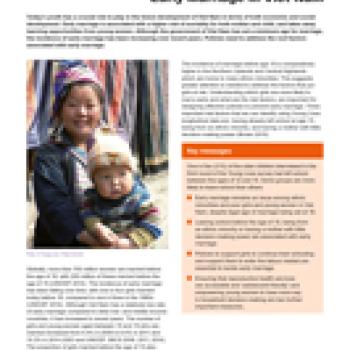Publication Information

Today’s youth has a crucial role to play in the future development of Viet Nam in terms of both economic and social development. Early marriage is associated with a higher risk of mortality for both mother and child, and takes away learning opportunities from young women. Although the government of Viet Nam has set a minimum age for marriage, the incidence of early marriage has been increasing over recent years. Policies need to address the root factors associated with early marriage. Globally, more than 700 million women are married before the age of 18, with 250 million of these married before the age of 15. The incidence of early marriage has been falling over time, with one in four girls married today before 18, compared to one in three in the 1980s. Although Viet Nam has a relatively low rate of early marriage compared to other low- and middle-income countries, it has increased in recent years. The number of girls and young women aged between 15 and 19 who are married increased from 5.4% in 2006 to 8.4% in 2011 and 10.3% in 2014. The proportion of girls married before the age of 15 also increased from 0.7% in 2006 and 2011 to 0.9% in 2014.
The incidence of marriage before age 15 is comparatively higher in the Northern Uplands and Central Highlands which are home to many ethnic minorities. This suggests greater attention is needed to address the factors that put girls at risk. Understanding which girls are more likely to marry early and what are the risk factors, are important for designing effective policies to prevent early marriage. Three important risk factors that we can identify using Young Lives longitudinal data are: having already left school at age 15, being from an ethnic minority, and having a mother with little decision-making power.
Key messages Early marriage remains an issue among ethnic minorities and poor girls and young women in Viet Nam, despite legal age of marriage being set at 18. Leaving school before the age of 15, being from an ethnic minority or having a mother with little decision-making power are associated with early marriage. Policies to support girls to continue their schooling and support them to enter the labour market are essential to tackle early marriage. Ensuring that reproductive health services are accessible and ‘adolescent-friendly’ and empowering young women to have more say in household decision-making are two further important measures.

Today’s youth has a crucial role to play in the future development of Viet Nam in terms of both economic and social development. Early marriage is associated with a higher risk of mortality for both mother and child, and takes away learning opportunities from young women. Although the government of Viet Nam has set a minimum age for marriage, the incidence of early marriage has been increasing over recent years. Policies need to address the root factors associated with early marriage. Globally, more than 700 million women are married before the age of 18, with 250 million of these married before the age of 15. The incidence of early marriage has been falling over time, with one in four girls married today before 18, compared to one in three in the 1980s. Although Viet Nam has a relatively low rate of early marriage compared to other low- and middle-income countries, it has increased in recent years. The number of girls and young women aged between 15 and 19 who are married increased from 5.4% in 2006 to 8.4% in 2011 and 10.3% in 2014. The proportion of girls married before the age of 15 also increased from 0.7% in 2006 and 2011 to 0.9% in 2014.
The incidence of marriage before age 15 is comparatively higher in the Northern Uplands and Central Highlands which are home to many ethnic minorities. This suggests greater attention is needed to address the factors that put girls at risk. Understanding which girls are more likely to marry early and what are the risk factors, are important for designing effective policies to prevent early marriage. Three important risk factors that we can identify using Young Lives longitudinal data are: having already left school at age 15, being from an ethnic minority, and having a mother with little decision-making power.
Key messages Early marriage remains an issue among ethnic minorities and poor girls and young women in Viet Nam, despite legal age of marriage being set at 18. Leaving school before the age of 15, being from an ethnic minority or having a mother with little decision-making power are associated with early marriage. Policies to support girls to continue their schooling and support them to enter the labour market are essential to tackle early marriage. Ensuring that reproductive health services are accessible and ‘adolescent-friendly’ and empowering young women to have more say in household decision-making are two further important measures.

